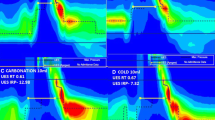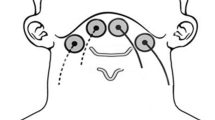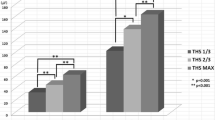Abstract
Although neuromuscular electrical stimulation (NMES) is increasingly used in dysphagia therapy, patient responses to NMES are inconsistent and conflicting results have been reported. This, together with a lack of information about the effects of NEMS on the swallowing process, has led to an ongoing debate about its impact on swallowing function. In order to address this, we set out to (i) collect baseline information on the physiological effects of NMES on the complex pharyngeal phase of swallowing and (ii) to compare two different stimulation protocols. In doing so, we provide information useful for evaluating the therapeutic effectiveness of NMES on the swallowing process. In a prospective study, 29 healthy participants performed water swallows after receiving continuous NMES for 10 min. The stimulus was applied in the submandibular region using one of two different stimulation protocols: low-frequency stimulation (LFS) and mid-frequency stimulation (MFS). Swallowing parameters of the pharynx and UES were measured using high-resolution manometry. Maximum tongue base pressure increased by 8.4% following stimulation with the MFS protocol. Changes in UES function were not found. LFS stimulation did not result in any significant changes in the parameters examined. The MFS protocol enhances tongue base retraction during swallowing in healthy volunteers. The magnitude of the effect, however, was small, possibly due to the ability of healthy subjects to compensate for external influences, such as NMES, and may actually prove to be much greater in patients with diminished tongue base retraction. Thus, further studies are needed to determine whether a similar effect is also achievable in dysphagic patients with impaired bolus propulsion, possibly allowing MFS stimulation of the tongue base region to be used as an additional treatment tool.


Similar content being viewed by others
References
Geeganage C, Beavan J, Ellender S, Bath PMW. Interventions for dysphagia and nutritional support in acute and subacute stroke. In: Bath PM, editor. The Cochrane database of systematic reviews, vol. 10. Chichester: Wiley; 2012. p. CD000323.
Miller S, Jungheim M, Kühn D, Ptok M. Electrical stimulation in treatment of pharyngolaryngeal dysfunctions. Folia Phoniatr Logop. 2013;65:154–68.
Carnaby-Mann GD, Crary MA. Examining the evidence on neuromuscular electrical stimulation for swallowing: a meta-analysis. Arch Otolaryngol Head Neck Surg. 2007;133:564–71.
Chen Y-W, Chang K-H, Chen H-C, Liang W-M, Wang Y-H, Lin Y-N. The effects of surface neuromuscular electrical stimulation on post-stroke dysphagia: a systemic review and meta-analysis. Clin. Rehabil. 2016;30:24–35.
Freed ML, Freed L, Chatburn RL, Christian M. Electrical stimulation for swallowing disorders caused by stroke. Respir. Care. 2001;46:466–74.
Huang K-L, Liu T-Y, Huang Y-C, Leong C-P, Lin W-C, Pong Y-P. Functional outcome in acute stroke patients with oropharyngeal dysphagia after swallowing therapy. J. Stroke Cerebrovasc. Dis. 2014;23:2547–53.
Kushner DS, Peters K, Eroglu ST, Perless-Carroll M, Johnson-Greene D. Neuromuscular electrical stimulation efficacy in acute stroke feeding tube-dependent dysphagia during inpatient rehabilitation. Am J Phys Med Rehabil. 2013;92:486–95.
Lee KW, Kim SB, Lee JH, Lee SJ, Ri JW, Park JG. The effect of early neuromuscular electrical stimulation therapy in acute/subacute ischemic stroke patients with dysphagia. Ann. Rehabil. Med. 2014;38:153–9.
Lim K-B, Lee H-J, Lim S-S, Choi Y-I. Neuromuscular electrical and thermal-tactile stimulation for dysphagia caused by stroke: a randomized controlled trial. J Rehabil Med. 2009;41:174–8.
Heijnen BJ, Speyer R, Baijens LWJ, Bogaardt HCA. Neuromuscular electrical stimulation versus traditional therapy in patients with Parkinson’s disease and oropharyngeal dysphagia: effects on quality of life. Dysphagia. 2012;27:336–45.
Ryu JS, Kang JY, Park JY, Nam SY, Choi SH, Roh JL, et al. The effect of electrical stimulation therapy on dysphagia following treatment for head and neck cancer. Oral Oncol. 2009;45:665–8.
Tan C, Liu Y, Li W, Liu J, Chen L. Transcutaneous neuromuscular electrical stimulation can improve swallowing function in patients with dysphagia caused by non-stroke diseases: a meta-analysis. J Oral Rehabil. 2013;40:472–80.
Bülow M, Speyer R, Baijens L, Woisard V, Ekberg O. Neuromuscular electrical stimulation (NMES) in stroke patients with oral and pharyngeal dysfunction. Dysphagia. 2008;23:302–9.
Kiger M, Brown CS, Watkins L. Dysphagia management: an analysis of patient outcomes using VitalStim therapy compared to traditional swallow therapy. Dysphagia. 2006;21:243–53.
Robertson V, Ward A, Low J, Reed A. Electrotherapy explained. 4th ed. Edinburgh: Butterworth Heinemann Elsevier; 2006.
Suntrup S, Teismann I, Wollbrink A, Winkels M, Warnecke T, Pantev C, et al. Pharyngeal electrical stimulation can modulate swallowing in cortical processing and behavior—magnetoencephalographic evidence. NeuroImage. 2015;104:117–24.
Burnett TA, Mann EA, Cornell SA, Ludlow CL. Laryngeal elevation achieved by neuromuscular stimulation at rest. J Appl Physiol. 2003;94:128–34.
Humbert IA, Poletto CJ, Saxon KG, Kearney PR, Crujido L, Wright-Harp W, et al. The effect of surface electrical stimulation on hyolaryngeal movement in normal individuals at rest and during swallowing. J Appl Physiol. 2006;101:1657–63.
Ludlow CL, Humbert I, Saxon K, Poletto C, Sonies B, Crujido L. Effects of surface electrical stimulation both at rest and during swallowing in chronic pharyngeal dysphagia. Dysphagia. 2007;22:1–10.
Ludlow CL. Electrical neuromuscular stimulation in dysphagia: current status. Curr. Opin. Otolaryngol. Head Neck Surg. 2010;18:159–64.
Park J-W, Oh J-C, Lee HJ, Park S-J, Yoon T-S, Kwon BS. Effortful swallowing training coupled with electrical stimulation leads to an increase in hyoid elevation during swallowing. Dysphagia. 2009;24:296–301.
Berretin-Felix G, Sia I, Barikroo A, Carnaby GD, Crary MA. Immediate effects of transcutaneous electrical stimulation on physiological swallowing effort in older versus young adults. Gerodontology. 2016;33:348–55.
Barikroo A, Berretin-Felix G, Carnaby G, Crary M. Effect of transcutaneous electrical stimulation amplitude on timing of swallow pressure peaks between healthy young and older adults. Gerodontology. 2017;34:24–32.
Jungheim M, Janhsen AM, Miller S, Ptok M. Impact of neuromuscular electrical stimulation on upper esophageal sphincter dynamics: a high-resolution manometry study. Ann. Otol. Rhinol. Laryngol. 2015;124:5–12.
Ward AR, Shkuratova N. Russian electrical stimulation: the early experiments. Phys Ther. 2002;82:1019–30.
Gallas S, Marie JP, Leroi AM, Verin E. Sensory transcutaneous electrical stimulation improves post-stroke dysphagic patients. Dysphagia. 2010;25:291–7.
Rofes L, Arreola V, López I, Martin A, Sebastián M, Ciurana A, et al. Effect of surface sensory and motor electrical stimulation on chronic poststroke oropharyngeal dysfunction. Neurogastroenterol Motil. 2013;25:888-e701.
Pandolfino JE, Ghosh SK, Zhang Q, Han A, Kahrilas PJ. Upper sphincter function during transient lower oesophageal sphincter relaxation (tLOSR); it is mainly about microburps. Neurogastroenterol Motil. 2007;19:203–10.
Kahrilas PJ. Pharyngeal structure and function. Dysphagia. 1993;8:303–7.
Dodds WJ, Man KM, Cook IJ, Kahrilas PJ, Stewart ET, Kern MK. Influence of bolus volume on swallow-induced hyoid movement in normal subjects. AJR Am J Roentgenol. 1988;150:1307–9.
Kahrilas PJ, Dodds WJ, Dent J, Logemann JA, Shaker R. Upper esophageal sphincter function during deglutition. Gastroenterology. 1988;95:52–62.
Lee HY, Hong JS, Lee KC, Shin Y-K, Cho S-R. Changes in hyolaryngeal movement and swallowing function after neuromuscular electrical stimulation in patients with Dysphagia. Ann. Rehabil. Med. 2015;39:199–209.
Acknowledgements
The authors are extremely grateful to Professor K. Hodges for his valuable ideas, constructive comments, and correction of the English text and to Mr. B. Vaske for his support with the statistical analyses.
Author information
Authors and Affiliations
Contributions
M.J. supervision of acquisition of data, analysis and interpretation of data, drafting of the manuscript. C.S. acquisition, analysis, and interpretation of data, contributions to the manuscript. S.M. technical support for neuromuscular electrical stimulation, contributions to the manuscript. M.P. study concept and design, study supervision, revision of the manuscript.
Corresponding author
Ethics declarations
Conflict of interest
Martin Ptok and Simone Miller received refund of travel expenses from Physiomed not related to this study. All authors declare that they have no conflict of interest.
Rights and permissions
About this article
Cite this article
Jungheim, M., Schubert, C., Miller, S. et al. Swallowing Function After Continuous Neuromuscular Electrical Stimulation of the Submandibular Region Evaluated by High-Resolution Manometry. Dysphagia 32, 501–508 (2017). https://doi.org/10.1007/s00455-017-9791-5
Received:
Accepted:
Published:
Issue Date:
DOI: https://doi.org/10.1007/s00455-017-9791-5




